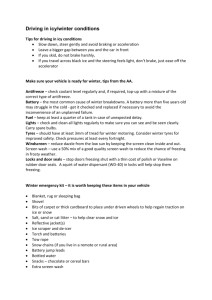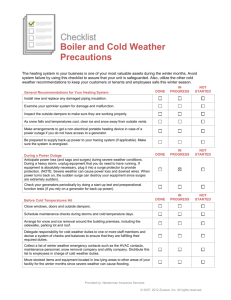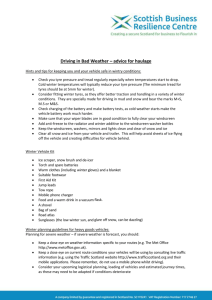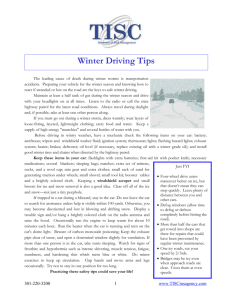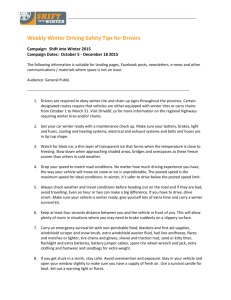Winters in Canada - Lacombe Neighborhood Place
advertisement
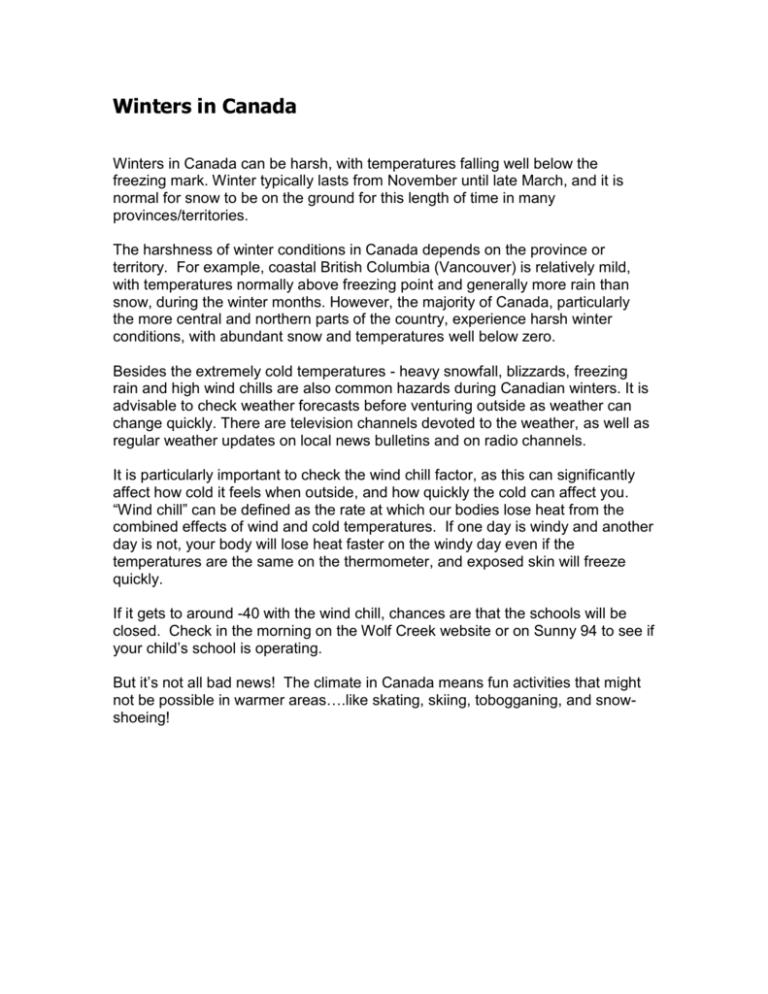
Winters in Canada Winters in Canada can be harsh, with temperatures falling well below the freezing mark. Winter typically lasts from November until late March, and it is normal for snow to be on the ground for this length of time in many provinces/territories. The harshness of winter conditions in Canada depends on the province or territory. For example, coastal British Columbia (Vancouver) is relatively mild, with temperatures normally above freezing point and generally more rain than snow, during the winter months. However, the majority of Canada, particularly the more central and northern parts of the country, experience harsh winter conditions, with abundant snow and temperatures well below zero. Besides the extremely cold temperatures - heavy snowfall, blizzards, freezing rain and high wind chills are also common hazards during Canadian winters. It is advisable to check weather forecasts before venturing outside as weather can change quickly. There are television channels devoted to the weather, as well as regular weather updates on local news bulletins and on radio channels. It is particularly important to check the wind chill factor, as this can significantly affect how cold it feels when outside, and how quickly the cold can affect you. “Wind chill” can be defined as the rate at which our bodies lose heat from the combined effects of wind and cold temperatures. If one day is windy and another day is not, your body will lose heat faster on the windy day even if the temperatures are the same on the thermometer, and exposed skin will freeze quickly. If it gets to around -40 with the wind chill, chances are that the schools will be closed. Check in the morning on the Wolf Creek website or on Sunny 94 to see if your child’s school is operating. But it’s not all bad news! The climate in Canada means fun activities that might not be possible in warmer areas….like skating, skiing, tobogganing, and snowshoeing! PEOPLE Dressing for Extreme Cold Temperatures Dress in layers, with a wind and waterproof outside layer. It is best to buy winter clothing that is made in Canada, as these are specifically made for the Canadian climate. Get proper insulated winter boots, designed to withstand very cold temperatures. Wear a good winter hat that covers your ears, and mittens or gloves. Mittens are warmer than gloves. Thermal undergarments (or Thinsulate long-johns and tops) are recommended to provide extra protection against the cold, if spending time outdoors in minus temperatures. Scarves are useful to cover the face and protect the mouth, nose and lungs from the cold air. Looking After Children in Winter Watch for frostbite on small children; notable signs include a small white patch on exposed skin. The cheeks are often the first to freeze, but bare fingers and ears will also freeze quickly. Dress children in layers and always make sure they wear mittens, hats and waterproof warm clothing. When you are thinking of how to dress a little child or baby, remember to dress them the same way you would dress yourself plus one extra layer. For a baby, this extra layer might be a blanket. Keep children dry. Try to play close to home on cold days so if they get wet, they can get home quickly to warm up. Watch out for shivering; this is a sign to go indoors. Wool socks and woolen garments next to the skin are advised, as they keep the skin warm and dry, unlike cotton which absorbs sweat and may get damp. Remember that damp clothing does not insulate well. Keep some good skin moisturizer on hand. This is available at drugstores, supermarkets and department stores. The cold, dry weather can make skin irritated, rough, and itchy. Moisturizers can really help when applied regularly. Your Vehicle Main roads are normally cleared by snowplows after a snow fall. Sometimes this can take a few days though, so there are times when driving on snow and ice is unavoidable. Drivers should prepare and maintain their vehicle for winter driving conditions in the following ways. Install winter tires. Canada has an industry standard for snow tires to help consumers identify which tires have the necessary traction for winter conditions. They are made of a softer rubber compound than all-season tires and the tread patterns are designed to provide the best grip. Make sure the fluid in the windscreen wiper reservoir and anti-freeze in the cooling system is designed for use in cold temperatures. When temperatures fall below freezing do not let the gas tank get too low or condensation will build up inside the tank, which then freezes into ice. When it melts, it combines with the gas and then freezes again in the gas line. This will cause problems keeping the vehicle running. You should always try to keep the fuel gauge above half. You don’t want to run out of gas and find yourself walking when it’s -30, either! When temperatures go below -20°C, a block heater or battery warmer may be necessary to ensure the engine starts properly. You’ll probably need extension cords to plug these into the electrical outlet on your house. Wash the vehicle regularly to get rid of salt and grit from the roads, because it is corrosive and will cause your vehicle to rust. The following items should be kept in the vehicle during the winter in the event of a breakdown: 1. 2. 3. 4. 5. 6. 7. 8. Small snow shovel Booster cables Cell phone and charger Brush and ice scraper Candle and matches or flashlight Additional warm clothing Bag of sand or cat litter Emergency food 9. Blankets and extra hats and gloves Your Driving Winter driving might sound scary when you’re new to it, especially when conditions are snowy or icy. Follow these steps to keep yourself safe and accident free during the next few blustery winter months. Step 1: Make sure that your vehicle is prepared for winter driving. Winter tires are a good option, as they will provide greater traction under snowy or icy conditions. Keep a snow brush/scraper in your car, along with possible emergency items such as a lightweight shovel, battery jumper cables, and a flashlight. Make sure that mirrors, all windows, and the top of your vehicle, are free of snow or frost before getting onto the road. Step 2: Drive smoothly and slowly Don’t make any abrupt turns or stops when driving. Doing so will often cause your vehicle to lose control and skid. Driving too quickly is the main cause of winter collisions. Be sure to drive slowly and carefully on snow and ice covered roads. Step 3: Don’t tailgate. Tailgating is a much bigger problem in winter, because stopping takes much longer on snowy and icy roads than on dry pavement. Be sure to leave enough room between your vehicle and the one in front of you for safe stopping. Step 4: Brake before making turns. Brake slowly to reduce speed before entering turns. Once you have rounded the corner you can accelerate again. Step 5: Learn how to control skids. When skidding, you actually need to go against your natural instincts and turn into the skid and accelerate. Doing so transfers your vehicle’s weight from the front to the rear and often helps vehicles to regain control. Step 6: Lights On. Turn on your lights to increase your visibility to other motorists. Step 7: No Cruise Control. Never use cruise control if conditions are snowy, icy, or wet, because if your car hydroplanes, your car will try to accelerate and you may lose control of your vehicle. Step 8: Don’t “pump” the brakes. If your vehicle is equipped with an anti-lock breaking system (ABS), do not “pump” the brakes. Apply constant pressure and let the system do its work. Step 9: Pay attention. Maneuvers are more difficult to make in the snow. Be sure to anticipate what your next move is going to be to give yourself lots of room for turns and stopping. Listen or watch for the regular weather bulletins. It is not recommended to drive when freezing rain or snowstorms are expected. HOMES Most homes in Canada are equipped with central heating and a thermostat, so internal temperatures can be easily controlled. Homes normally have electric heaters, natural gas or oil furnaces which blow warm air through vents. Canadian homes are also well insulated and therefore, stay warm. Most people find 20-22C a comfortable temperature when they are home – but you must keep your house at least 5C in the winter even if you are not at home, because your water pipes could freeze and burst if your house gets too cold. Winters are often dry and cold so static electricity can be a problem. Fabric softeners and humidifiers can help reduce the problem in your home, but nothing completely eliminates the problem – we learn to live with hair that sometimes stands straight up, clothes that cling, and getting a snap on the finger whenever we turn on the lights. Homes should be prepared for winter by checking to make sure your air vents are not obstructed and that your windows seal tightly, and either replacing furnace filters or keeping them clean if you have the washable type. Households should have flashlights and extra batteries stored in a handy place inside the home, in case of power outages caused by high winds or snowstorms. Use sand or commercial ice melting products to keep steps and pathways free of slippery and dangerous ice. Driveways and sidewalks need to be cleared from snow on a regular basis. You can either plan do the shoveling yourself or hire someone to do it for you – but either way it must be done because most city bylaws require it. If you are going to do your own shoveling, you’ll need a snow shovel which can be bought at most large supermarkets, hardware stores, or department stores. If you have a large driveway, maybe you could invest in a snow blower. They can be fairly expensive but it’s a quicker and less labour intensive way to clear a big driveway!




